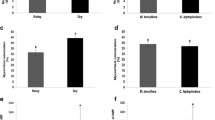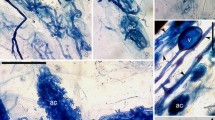Abstract.
Morphological types of arbuscular mycorrhizal (AM) fungi in roots of understorey plants were examined in three different Japanese deciduous broadleaved forests. In total, 43 species belonging to 33 genera from 27 families were examined for the morphological types of AM. The number of flowering plant species having Paris-type AM was greater than those having Arum-type AM in each plot. This tendency was more prominent in herbaceous plants than woody plants with nine species having Paris-type associations among ten herbaceous plant species examined. Therefore, it is suggested from the ecological point of view that Paris-type associations could be advantageous for the herbaceous understorey plants growing slowly in these environments. The influence of plant identity on the morphological types of AM was also discussed by arranging the plants examined with the morphological types in a current plant phylogeny scheme. In this study, some new records on the morphological types of AM in some new plant families were obtained including the first report of a typical Arum-type AM in gymnosperms.
Similar content being viewed by others
Author information
Authors and Affiliations
Additional information
Electronic Publication
Rights and permissions
About this article
Cite this article
Yamato, M., Iwasaki, M. Morphological types of arbuscular mycorrhizal fungi in roots of understory plants in Japanese deciduous broadleaved forests. Mycorrhiza 12, 291–296 (2002). https://doi.org/10.1007/s00572-002-0187-4
Received:
Accepted:
Issue Date:
DOI: https://doi.org/10.1007/s00572-002-0187-4




